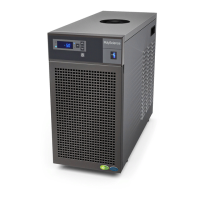Startup
Process Coolant
Suitable Fluids
WARNING: Only use fluids that will satisfy safety, health, and equipment compatibility requirements.
Caustic, corrosive, or flammable fluids must never be used.
The Chiller is designed to accommodate a variety of coolant fluids (water, glycol mixtures, etc). For most
applications above 20°C (68°F), distilled water is satisfactory. For operation at or below 20°C (68°F), the
Chiller must be protected with an antifreeze solution. Ethylene glycol (laboratory grade) and distilled water in
a 50/50 mixture is satisfactory from +20° to -15°C (68° to 5°F). Select a fluid that is compatible with the
Chiller’s wetted parts (brass, copper, stainless steel, EPDM rubber, Alcryn, nylon, PVC, and polyethylene).
WARNING: Do not use caustic, corrosive, or flammable fluids.
WARNING: Operation below 20°C (68°F) requires antifreeze in the circulation fluid.
To prevent algae growth in the system, shield tubing from light. Insulation around the tubing will suffice. Use
an algaecide in the cooling water to minimize algae growth.
WARNING: Do NOT use chlorine bleach as an algaecide.
WARNING: Do not use the following fluids
• Automotive antifreeze with additives**
• Hard tap water**
• Deionized water with a specific resistance > 1 meg ohm
• Any flammable fluids
• Concentrations of acids or bases
• Solutions with halides: chlorides, fluorides, bromides, iodides or sulfur
with chromates or chromium salts
** o
igher temperatures and higher concentrations of additives can
build up.
• Bleach (Sodium Hypochlorite)
• Solutions
• Glycerin
• Syltherm fluids
At temperatures above 40°C, additives or mineral deposits can adhere to the heater. If deposits are allowed t
build up, the heater may overheat and fail. H
hasten deposit
Filling the Reservoir
Unscrew the reservoir cap and carefully fill the reservoir with fluid. Leave the cap off and add additional fluid
s instructed under Starting Process Fluid Flow, below. a
7
110-445

